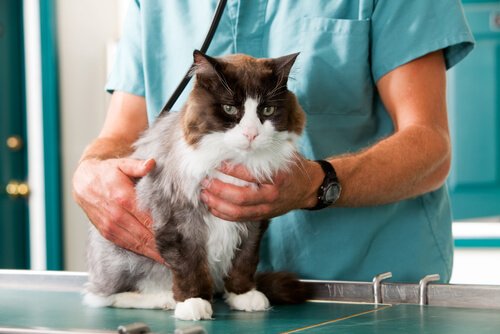Toxoplasmosis in Cats


Written and verified by the lawyer Francisco María García
Toxoplasmosis is a disease caused by a parasite called Toxoplasma gondii. Since it’s asymptomatic, it’s not easily detected. Although it can be transmitted from animals to humans, the most common routes of infection for humans are other humans.
There are quite a few myths about toxoplasmosis in cats and the risk that cats pose for humans. So today we’re going to address these myths and provide helpful information on how to handle this disease.
What is Toxoplasmosis in Cats?
Toxoplasmosis is an infectious disease caused by one of the most widespread parasites in the world: Toxoplasma gondii.
This organism can infect all mammals. The only animals that eliminate the disease through their feces or are otherwise transmitters/final hosts of the parasite are felines. The rest keep it in their bodies and can only infect a person if they ingest their raw or undercooked meat.

Why are cats transmitters of toxoplasmosis? Well, because of the way their bodies are designed, toxoplasmosis can develop in their intestinal tracts.
Risk of Contagion in Humans
Despite popular belief, having a cat as a pet does not increase your risk of contracting toxoplasmosis. In fact, it is highly unlikely that felines are responsible for spreading the disease to humans, even if the humans in question are pregnant. Why? Because there has to be a series of specific circumstances which rarely occur simultaneously. Namely:
- For the animal to be infected for the first time, since once the cat has contracted the disease, it acquires immunity.
- When a cat’s feces remain in the same place for more than 24 hours and less than five days.
- For a person who has come in contact with cat stools with their bare hands to place them near their mouth or use them for handling food.
Even if the pet is infected, it’s difficult for the disease to spread to the people who live with the cat. In any case, situations of toxoplasmosis transmission are more common in men. This occurs due to ingestion of raw or undercooked meat, contaminated fruits or vegetables, and improperly sanitized drinking water.
Animal Contagion
To contract the disease, the cat must come into contact with the parasite by eating contaminated meat. It could happen by eating a rodent, a bird or another type of sick animal, or by consuming raw meat that was already infected.
If the cat is a pet, it’s most likely to be fed at home with store-bought cat food. These types of food hardly ever come in contact with infectious feces.
Upon contracting the virus, toxoplasmosis in cats takes about 15 days to reproduce. It lodges in the animal’s intestines, producing eggs called oocysts, which are eliminated through the cat’s stools.
Being an asymptomatic disease, the animal will not show that it’s sick. However, watch out for certain warning signs, such as:
- Diarrhea
- Loss of appetite
- Fever
- Apathy
- Difficulty breathing
- Low immunity
If you detect any of these symptoms, take the cat to a trusted veterinarian. The vet will draw blood, make the proper diagnosis, and recommend treatment.
How to Prevent Toxoplasmosis in Cats
It is possible to prevent cats from contracting this parasite by taking a few very simple precautionary measures:
- First of all, watch your cat’s diet and where you feed him. If you give your cat store-bought food or homemade, completely cooked food, he’ll be safe.
- Avoid feeding your cat raw meat at all costs. Be sure to keep an eye on whether your cat comes in contact with strange animals.
- Be sure that your cat’s vaccines are up-to-date. Go to the vet for regular check-ups to confirm that your cat’s health is in optimal condition.

Treatments for Toxoplasmosis in Cats
If a vet diagnoses the disease, they’ll likely prescribe antibiotics for at least two weeks. All of this depends on the cat’s development and symptoms, however. Antibiotics will keep the disease from progressing and allow the animal to recover.
Safety Measures in Your Home
In short, toxoplasmosis in cats can occur without symptoms. The important thing is to take care of your cat’s diet and hygiene and be sure to go to the veterinarian if you notice any abnormal behavior or symptoms.
It should be reassuring to know that having a cat doesn’t put you or your family at risk. However, always take all the precautionary measures into account and stay on top of them.
This text is provided for informational purposes only and does not replace consultation with a professional. If in doubt, consult your specialist.